NIF & PS People - 2018
August
NIF&PS Honors Five Summer Scholars
Summer Scholars Tackle Big Science
Two NIF&PS Researchers Named to ‘40 Under 40’ List
NIF & Photon Science scientists Louisa Pickworth and Leily Kiani are among five LLLNL researchers joining an eclectic group of entrepreneurs, writers, executives, philanthropists, and more on Diablo Magazine’s annual “40 Under 40” list. The list recognizes young professionals in the East Bay who are leading the charge in their fields.
 Leily Kiani (left) and Louisa Pickworth. Credit: Julie Russell
Leily Kiani (left) and Louisa Pickworth. Credit: Julie Russell Pickworth, an experimental physicist and group leader in the Lab’s Physics Division, works on NIF x-ray diagnostics and inertial confinement fusion (ICF) experiments. She designs complex diagnostics that allow scientist to use x rays to peer inside ultra-high-energy physics experiments and has developed techniques to study physics affecting ICF implosions. Click here for a profile and video.
Kiani, a postdoctoral researcher in the Fiber Technologies Group, works on extending the utility of fiber lasers by increasing the frequency ranges accessible to fiber-based systems through novel fiber development and nonlinear frequency conversion. A recent focus of her work has been to investigate sources of undesirable background energy in short-pulse fiber amplifiers, important for laser-driven particle accelerators as well as other laser-matter interaction experiments.
NIF&PS Honors Five Summer Scholars
Five NIF & Photon Science summer scholars received top honors from the Directorate this month for posters showcasing their scientific projects at the Laboratory.
Three of the students, Tony Wang and Joseph Gordon of UC Berkeley and Spencer Jeppson of Brigham Young University, presented posters that ranked in the top 10 per cent during LLNL’s annual two-day, Lab-wide summer poster symposium on Aug. 8 and 9.
A week later, the NIF&PS Directorate hosted a “mini-symposium” to showcase Wang, Gordon, and Jeppson, along with Joshua Ludwig of the University of Alberta and Angela Chen of U.C. San Diego, as the top NIF&PS participants in the Lab’s poster event.
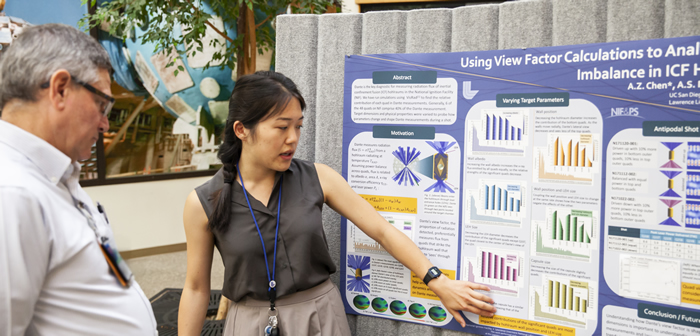 Summer scholar Angela Chen describes her poster to NIF&PS Principal Deputy Principal Associate Director Jeff Atherton.
Summer scholar Angela Chen describes her poster to NIF&PS Principal Deputy Principal Associate Director Jeff Atherton. The five students displayed “incredible enthusiasm” and a “fire-in-the-belly” attitude while working at the Lab, said NIF & Photon Science Principal Associate Director Jeff Wisoff after he met with each scholar.
“It’s amazing to see the breadth of the projects, going across a wide spectrum, from detectors to fundamental optics effects,” Wisoff said. “It’s always refreshing and invigorating to see them ready to go, roll up their sleeves, do the hard work and be excited about it.”
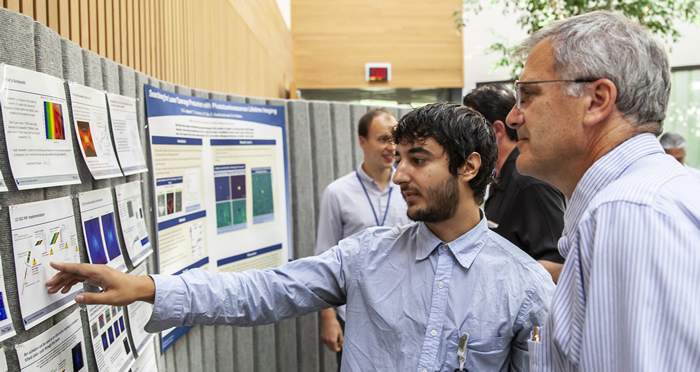 Joshua Ludwig and NIF&PS Principal Associate Director Jeff Wisoff review Ludwig’s poster.
Joshua Ludwig and NIF&PS Principal Associate Director Jeff Wisoff review Ludwig’s poster. The students were among a group of 57 NIF&PS summer scholars here this year, and Wisoff said he would like to see them consider working at the Lab.
“Whether they chose the laboratory or not, hopefully this is an experience which will broaden their horizons and make them think about going into a career in a related field, which is all good for the U.S.,” Wisoff said.
Here’s what the five scholars presented:
- Chen, 21, ran computer simulations to calculate how Dante spectrometers measure x rays inside a target hohlraum using a variety of different parameters. The experiments were aimed at identifying trends in laser power and how the hohlraum was performing depending on these varying parameters. Chen, who graduated this year with a degree in physics, with a specialization in computational physics, plans to apply for graduate school in the fall. Last year, she interned with the Lab’s Physical and Life Sciences Directorate.
- Wang, 21, monitored changes that the anti-reflective sol-gel used on NIF optics undergos when exposed to different humidity and pressures. In particular, he examined how the coating loses thickness or water resistance with use. Wang is a material science and engineering major with a minor in electrical engineering. He now lives in Livermore but grew up in nearby Pleasanton and graduated from Foothill High School.
- Jeppson, 23, looked for ways to predict laser damage in hafnia-coated optics by scanning the optics before and after high-energy laser shots, cataloging areas of high-density luminescent photons and seeing if those correspond to areas of damage. Jeppson, who grew up in Livermore and graduated from Granada High School, is a senior chemistry major.
- Gordon, 22, employed the Geant4 (for GEometry ANd Tracking) physics simulation software package to examine how current NIF diagnostic tools are performing. The project is aimed at better characterizing uncertainties such as ion temperatures and hot-spot velocities and predicting ways to make diagnostic tools perform better. Gordon, who hails from the Chicago area, just graduated with a B.S. in nuclear engineering. He plans to find work as a researcher for a year before going on to graduate school.
- Ludwig, 25, investigated new methods to achieve high bandwidth on high-power lasers for use in plasma photonics experiments and to look for ways to reduce laser-plasma instabilities in inertial confinement fusion and high energy density experiments. This was the plasma physics graduate student’s third summer at the Lab (for more about Ludwig, see below).
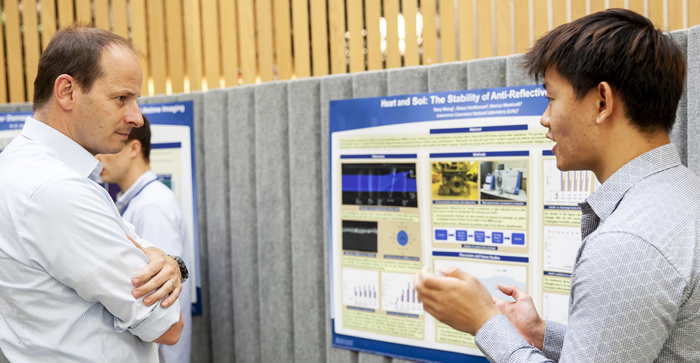 Tony Wang shows his “Heart and Sol” poster to Constantin Haefner, NIF&PS Program Director for Advanced Photon Technologies.
Tony Wang shows his “Heart and Sol” poster to Constantin Haefner, NIF&PS Program Director for Advanced Photon Technologies. 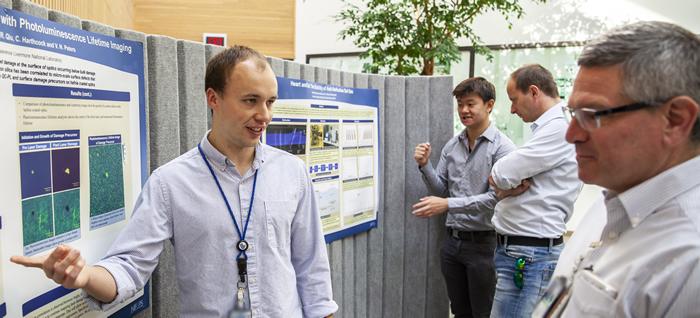 Spencer Jeppson and Jeff Atherton review Jeppson’s poster.
Spencer Jeppson and Jeff Atherton review Jeppson’s poster. 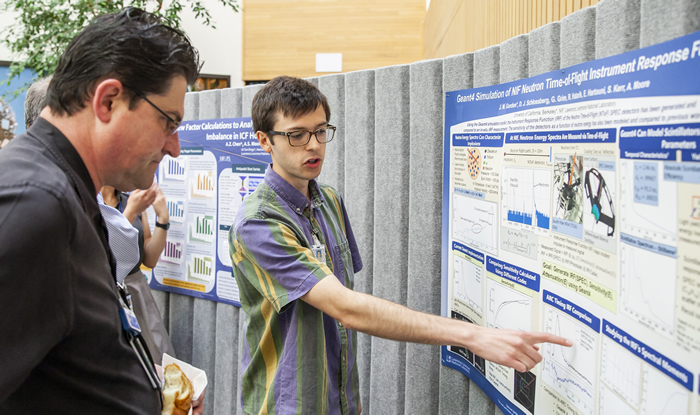 Joseph Gordon and NIF Operations Manager Bruno Van Wonterghem with Gordon’s poster.
Joseph Gordon and NIF Operations Manager Bruno Van Wonterghem with Gordon’s poster. The students had to adapt quickly after coming to the Lab.
Gordon, for example, said he first had to learn to use Geant4, “which took me a couple of weeks to learn. It’s pretty intimidating at first.”
As for Chen, “I didn’t even know how hohlraum was spelled,” she quipped.
Wang, Gordon, and Jeppson were among the 28 students who received awards of $150 from the Livermore Lab Foundation during the Lab-wide poster symposium.
NIF&PS Principal Deputy Principal Associate Director Jeff Atherton and Operations Manager Bruno Van Wonterghem also met with the NIF&PS scholars.
“I don’t worry about the future of the Laboratory when we’ve got young, really smart, and talented people like this coming through,” Atherton said. “We’re going to be just fine.”
—Benny Evangelista; Photos by Mark Meamber
Summer Scholars Tackle Big Science
As this year’s crop of NIF & Photon Science summer scholars have discovered, working at the Lab isn’t about traditional internship chores like making trivial coffee runs.
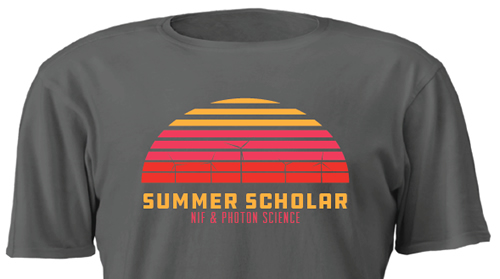
The 57 scholars representing more than two dozen schools in the United States and abroad have been challenged to work with world-class scientists as their mentors and contribute to the advancement of science.
And as the following profiles in this and the next issue of NIF & Photon Science News show, the scholars are not only meeting and exceeding those challenges, they’re giving something back to their mentors.
“When you teach something that you’re an expert in to somebody who’s never seen it before, it asks you to revisit assumptions you’re making on a day-to-day basis,” said NIF physicist Louisa Pickworth, who for the first time is co-managing the NIF & Photon Science Summer Scholars Program, working with longtime coordinator Reggie Drachenberg.
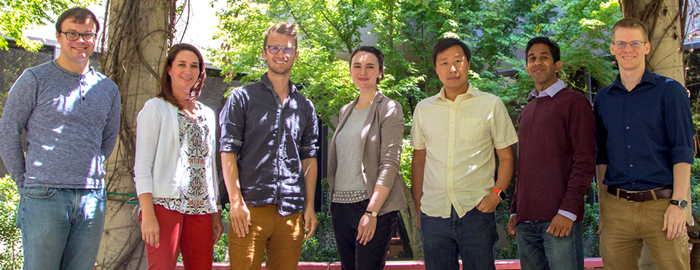 Summer Scholar Program leaders (from left) Sam Schrauth, Krista Ladner, Reggie Drachenberg, Louisa Pickworth, Zhi Liao, Rajesh Raman, and Patrick Poole. The team works to bring a variety of activities and opportunities to the summer scholars working at NIF & Photon Science, including a seminar series highlighting the variety of Directorate research, a career panel, offsite tours, and networking events including doughnuts and lunches that let the students meet staff members and NIF Management.
Summer Scholar Program leaders (from left) Sam Schrauth, Krista Ladner, Reggie Drachenberg, Louisa Pickworth, Zhi Liao, Rajesh Raman, and Patrick Poole. The team works to bring a variety of activities and opportunities to the summer scholars working at NIF & Photon Science, including a seminar series highlighting the variety of Directorate research, a career panel, offsite tours, and networking events including doughnuts and lunches that let the students meet staff members and NIF Management. “So, mentoring is an incredibly valuable opportunity for everybody,” she said. “It’s very invigorating to work with those students and see them being excited about science, introducing them to NIF and working here at Livermore for the first time.”
The lab has seen a 75 percent increase in the hiring of post-doctoral researchers and students in the past four years.
That makes programs like summer scholar a pipeline for “attracting that talent into the directorate for the future,” Pickworth said. “It’s an investment, really, and it’s great to be a part of.”
—Stories by Benny Evangelista
Measuring Plasma Temperature During NIF Shots
Getting Up to Speed on Laser-Plasma Interactions
Teamwork Propels Summer Scholars to New Discoveries
Helping Automate Control System Software Revisions
New Fiber Optics Design Measures NIF Beamline Performance
Measuring Plasma Temperature During NIF Shots
Nick Parrilla first became fired up about NIF after hearing LLNL physicist Thomas Dittrich speak to his high school physics class. Naturally, he’s thrilled to be working this summer as a NIF & Photon Science summer scholar.
“I remember hearing the talk, hearing about all the great research that goes on here,” said Parrilla, 21. “It’s what made me want to major in physics in the first place.”
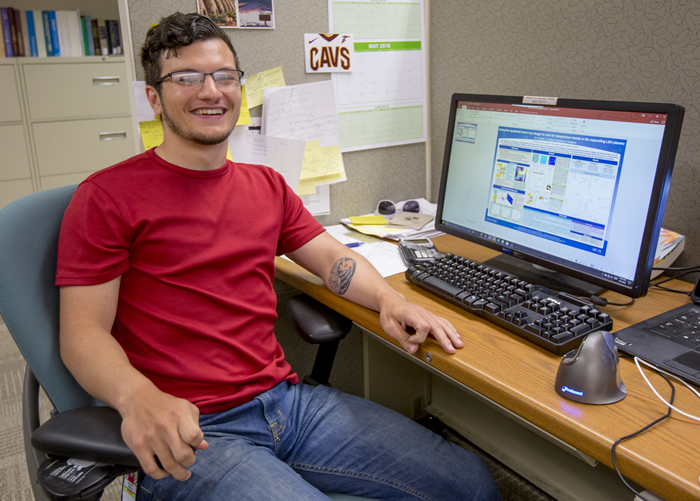 NIF & Photon Science summer scholar (and Cleveland Cavaliers fan) Nick Parrilla. Credit: Jason Laurea
NIF & Photon Science summer scholar (and Cleveland Cavaliers fan) Nick Parrilla. Credit: Jason Laurea Parrilla will return to Case Western Reserve University in Cleveland, Ohio, in September to start his senior year following his second stint as a summer scholar.
NIF physicist Joe Ralph put him in charge of a project to employ x-ray diagnostics to measure the temperatures of plasma that is being pushed just outside the hohlraum’s laser entrance holes during NIF shots (see “How NIF Targets Work”).
Parrilla is using diagnostic tools and filters that NIF scientists built a couple of years ago, but have not had time to use, Ralph said.
“This is the first time they’ve been analyzed like this,” he said. “So, having him as a summer student is just great.”
And with the previous summer’s experience under his belt, “he’s hit the ground running right away,” Ralph said. “He is driven. He puts a lot of work in, he’s highly motivated, he catches on very quickly. He has his own ideas. And he’s always pushing me to look at newer things or extend what we can see.”
Parrilla first heard about the Laboratory in 2014 when Dittrich, of the Design Physics Division, visited his class at St. Edward High School in Lakewood, Ohio, to talk about NIF and inertial confinement fusion research. Dittrich graduated from the suburban Cleveland school in 1966.
First Choice
After entering college, Parrilla thought again about LLNL when he started looking for potential internships. “This was the first place I applied to,” he said. “I thought it was a natural progression.”
He contacted Dittrich to learn more and was selected for Lab internship in 2017.
“Nick is a very hard worker,” Dittrich said. “I have spent considerable time with him and have seen him grow professionally to be a significant contributor to his project. Nick is also very focused on his goal of attaining a PhD in physics and perhaps working at a national lab such as LLNL.”
Dittrich said his experience with Parrilla shows the impact Lab scientists and their work can have on students.
Reaching out to students “at the high school level is extremely important,” he said. “Students at that age are starting to make career decisions and are very interested in what is out there.”
Once he started at NIF, Parrilla’s biggest challenge was learning about everything involved in the project.
“I read a lot of papers, read a lot of text books, went to a lot of meetings,” he said. “The most difficult part was something that I came across last summer, just being overwhelmed by how much there is going on in one of these experiments. There are acronyms for everything. So, learning how everything’s set up and works is definitely the first hurdle.”
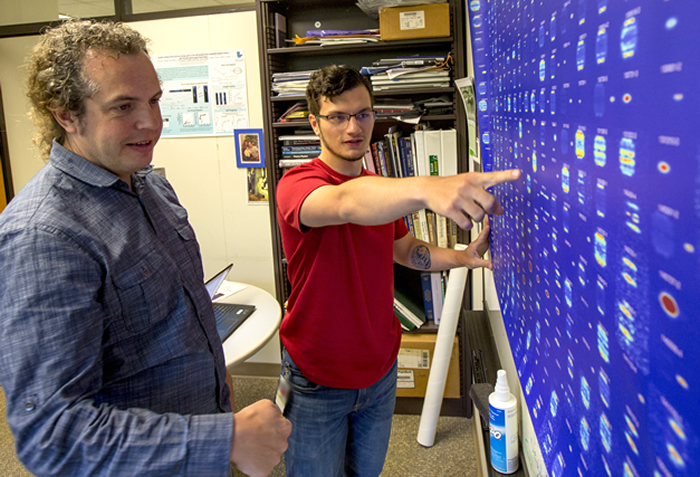 Parrilla shows mentor Joe Ralph x-ray diagnostic data from NIF implosions. Credit: Jason Laurea
Parrilla shows mentor Joe Ralph x-ray diagnostic data from NIF implosions. Credit: Jason Laurea Last summer, Ralph “really guided me and gave me a lot of information when I needed it,” Parrilla said. “This summer, I’m allowed to experience just being an independent researcher, asking questions about what’s going on and looking into it myself and not having any required direction I need to go in or anything I’m told to do.”
He’s learned a lot from both experiences.
“I definitely needed the help last summer,” he said. “And this summer, I think I’m really maturing as a researcher by getting to lead this project.”
Ralph hopes Parrilla’s work will eventually help NIF recover more plasma temperature data from inside the hohlraum as well.
“I’ve talked about how we can apply some of the same principles to other diagnostics,“ Ralph said. “The methods are similar to extract the information, but it would be more relevant to the temperature inside. So, we’re hoping to get that down the road.”
And five years down the road, Parrilla hopes he’s back at NIF.
I’d love to work here, although I might still be in graduate school,” he said. “If not, I would love to be involved in fusion research somewhere.”
Getting up to Speed on Laser-Plasma Interactions
When NIF & Photon Science summer scholar Joshua Ludwig reported to the Lab in May, his mentor Pierre Michel was concerned that he had “completely overwhelmed” the plasma physics graduate student with information about his projects.
But the 25-year-old Ludwig wasn’t fazed. Instead, he learned quickly and earned high praise for his work on the use of high-bandwidth lasers for plasma photonics experiments related to inertial confinement fusion (ICF) and high energy density (HED) research.
“The amount and quality of the work he produced just during these two months is what we would normally expect from an experienced staff scientist, perhaps even better,” said Michel, the NIF & Photon Science laser-plasma applications group leader.
 Joshua Ludwig displays visual representations of his work this summer on his computer monitors. Credit: Jason Laurea
Joshua Ludwig displays visual representations of his work this summer on his computer monitors. Credit: Jason Laurea Ludwig, a University of Alberta graduate student, said his assignment fit his academic and personal interests.
“I have some experience with Fourier transforms (a method of representing a waveform), so it came natural to work though that stuff fairly quickly,” Ludwig said. “I love programming, too. I do that as a hobby. In the evenings, I’ll work on that stuff at home just for fun.”
This summer is Ludwig’s third at the Lab. He previously worked on a project aimed at increasing the effective distance for laser wakefield acceleration, which uses a high-intensity short laser pulse to generate waves in a plasma, accelerating electrons like surfers over ocean waves.
He was the first author of a Physics of Plasmas paper published this spring on the results of that research, which showed that a second lower-power laser beam traveling in the opposite direction can help maintain the first wave-generating laser as it loses energy and spreads in space.
This year, Michel asked Ludwig to focus on something different: investigating new ways to achieve high bandwidth on high-power lasers, applying those lasers for plasma photonics experiments, and mitigating laser-plasma instabilities in ICF and HED experiments.
“As soon as I got here, we were looking at speckle (nonuniformity, or “hot spot”) movement on the NIF laser,” Ludwig said. “I wrote a code that simulates different optical elements from NIF and then we used it to characterize the speckle movement to see how we can speed it up to prevent laser-plasma instabilities.”
Joshua Ludwig created this video from images of speckle (nonuniformity, or “hot spot”) movement simulations he studied this summer at NIF:
“It was along the lines of stuff that interested me,” he said. “I have some experience with signal processing and my bachelor’s degree was actually in geophysics. That prepared me for that kind of stuff.”
He said much of his work with laser light propagation through optical components “takes advantage of the computational speed and mathematical relations of the Fourier transform.”
Michel said he was surprised at how fast Ludwig got up to speed.
“He absorbed it in an incredible amount of time,” Michel said. “I really didn’t expect he would get it so quickly.”
Intuition for Physics
Ludwig has an inner drive and “intuition for physics” that lets him quickly process large amounts of information, Michel said. “When he has a big, complicated program, he is able to break it down into smaller pieces that are easier to manage one by one.”
In early July, Ludwig travelled to Maine to represent the Lab at the Anomalous Absorption Conference, a small but prestigious gathering of the world’s top laser-plasma interaction (LPI) experts.
He delivered a poster on the “design of a high-bandwidth probe laser for LPI and plasma photonics experiments.” Michel said his colleagues at the conference told him they thought Ludwig presented the best poster overall.
“He’s very enthusiastic,” Michel said. “He’s also very mellow and a very nice guy, but at the same time, he’s very driven.”
Perhaps that’s why Ludwig, who grew up in the Canadian city of Red Deer in central Alberta, was drawn to the Bay Area.
“I’ve always wanted to live in California, even as a kid growing up,” he said. When the Lab internships came up, he said, “it was kind of a no-brainer when I got the opportunity.”
He’ll be getting more time here: Ludwig has agreed to an offer for an extended appointment as a temporary student intern until next May. He then hopes to have another stint as a summer scholar after that before returning to Alberta to finish his PhD.
And after that, he might want to return again to the Lab, which he first learned about in high school when he watched a BBC documentary on NIF.
“I would love to work on NIF,” Ludwig said. “Working on something related to fusion would be pretty cool. It’s something we need, so whatever I could contribute to that would be great.”
Teamwork Propels Summer Scholars to New Discoveries
A group of NIF & Photon Science summer scholars and visiting graduate students are experiencing the value of teamwork as they conduct experiments at LLNL’s Jupiter Laser Facility (JLF).
Jesus Hinojosa, 26, a University of Michigan graduate student, and Matthew Thibodeau, 21, a Rice University undergraduate, joined a team of veteran scientists and researchers to explore ways to develop new x-ray light sources to apply in high energy density (HED) science experiments.
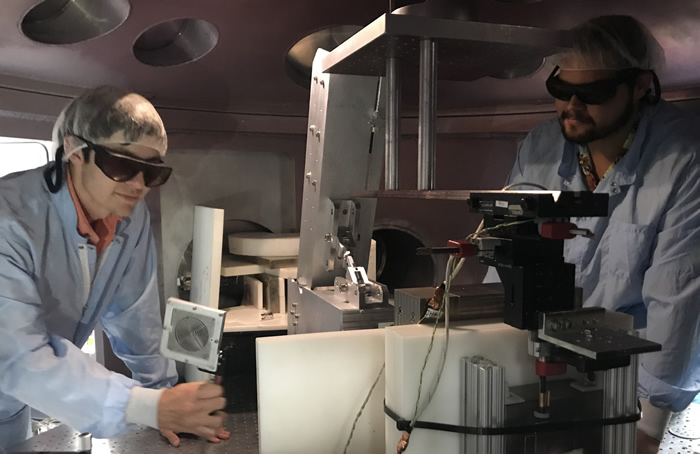 Summer scholars Matthew Thibodeau (left) and Jesus Hinojosa prepare for an experiment at the Jupiter Laser Facility. Credit: Félicie Albert
Summer scholars Matthew Thibodeau (left) and Jesus Hinojosa prepare for an experiment at the Jupiter Laser Facility. Credit: Félicie Albert “I’m really excited to see whether these will lead to new experiments in the future,” said Thibodeau, a senior physics and math major. “I know one of the goals is to find things that are interesting, but don’t have time to look fully into now. That’s the nice thing about science. We’re always opening doors for ourselves for the future.”
And the JLF is the place to learn what high-intensity lasers do to matter, said Hinojosa, an applied physics grad student. “There’s not a whole lot of other places that can study that,” he said. “This laser is definitely one to use for HED science.”
The scholars teamed with Paul King, 29, a University of Texas at Austin graduate physics student who is a member the Livermore Graduate Scholar Program (LGSP); Brian Kraus, 25, a visiting Princeton University grad student; and Elizabeth Grace, 25, a visiting Georgia Tech physics PhD student specializing in laser pulse measurement.
They’re working with principal investigator Félicie Albert, a physicist who has worked for the lab for 10 years, to accelerate particles through a regime called self-modulated laser wakefield acceleration.
The work is supported by two of Albert’s research grants, one from the Laboratory Directed Research and Development (LDRD) program, and the other an early career research program award from the Department of Energy (DOE) Office of Science. The experiments, conducted on JLF’s Titan laser, is also co-led by King and Nuno Lemos, a postdoc researcher who has worked with Albert at the lab for two years.
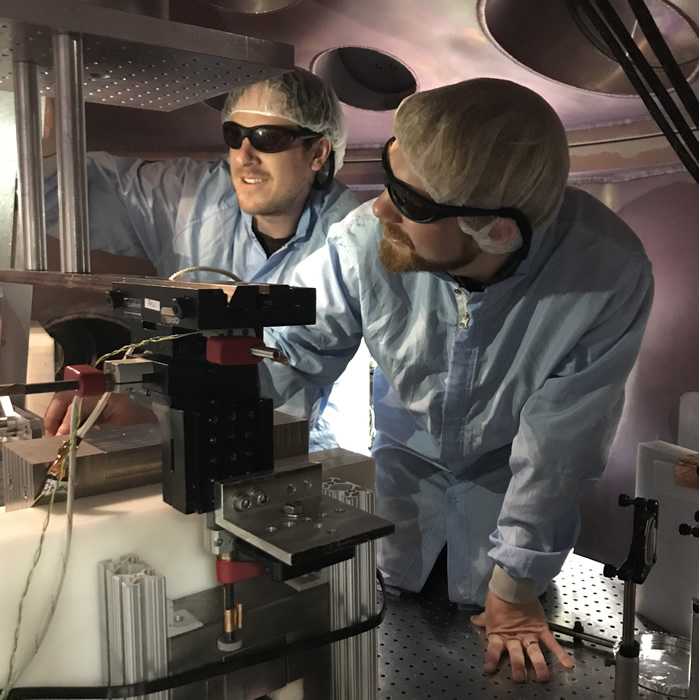 Graduate students Paul King (left) and Brian Kraus make adjustments to the JLF’s Titan Laser. Credit: Félicie Albert
Graduate students Paul King (left) and Brian Kraus make adjustments to the JLF’s Titan Laser. Credit: Félicie Albert By using laser-driven plasma to accelerate electrons, the project’s goal is to generate novel x-ray light sources for applications such as radiography, King said. The group has collaborated with other LLNL departments to experiment with different types of radiography targets. “Seeing the resolution of our images from these x rays was really exciting to me,” he said.
The experiments required close teamwork, including shifting roles and learning different jobs, said Kraus, who brought his expertise with spectrometers to the group to focus on specific details of x rays.
“There’s a lot of different levels of expertise here, from basically beginners to really experienced, and everyone counts, which is great,” he said. “The newest person can still discover something.”
“It brings people from all different schools, from whatever research they’re doing, in here to do something totally different,” Kraus added. “Every day, we have a plan of what’s going to happen. But then the first shot happens, and everything is totally different than we thought, so we change our plans.”
Those changes spur various conversations, including “us talking with mentors, talking amongst ourselves, trying to understand what we see and then what we do about it,” he said. “So, the plan is collaborative.”
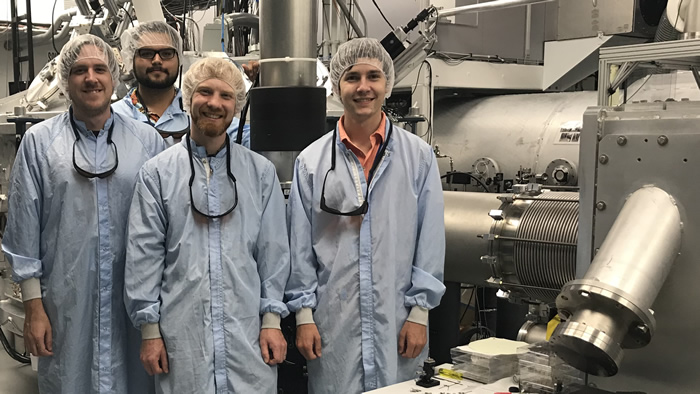 Students (from left) Paul King, Jesus Hinojosa, Paul Kraus and Matthew Thibodeau in the Jupiter Laser Facility. Credit: Félicie Albert
Students (from left) Paul King, Jesus Hinojosa, Paul Kraus and Matthew Thibodeau in the Jupiter Laser Facility. Credit: Félicie Albert Albert said such lessons are valuable to both the young scholars and to existing lab scientists like herself “because they’re the next ‘us.’”
“It’s a real pleasure to try to have an impact on younger scientists’ careers, because I was in their shoes once,” she said. “Having them get as much hands-on experience as possible, tweaking things, understanding the setup, rather than me doing stuff is also important for them because they have to learn.”
And collaboration and teamwork are essential to science.
“I wouldn’t be half of what I am today without my teammates and collaborators, whether they are more senior or more junior than I am,” Albert said.
She also noted that King was a summer scholar two years ago and will be the first author of an upcoming paper.
“That shows this program is a great pipeline to bring great talent to the Lab,” she said.
Helping Automate Control System Software Revisions
Zach DiPasquale enjoys designing software applications. That’s why the 21-year-old is relishing his time at NIF as he plays a role in better automating software upgrades to the Integrated Computer Control System (ICCS), which runs the world’s largest and most energetic laser.
“It took me a couple of weeks to understand it,” said DiPasquale, one of this year’s NIF & Photon Science summer scholars. “Figuring out the architecture of the system is a difficult task simply because there’s a lot going on.”
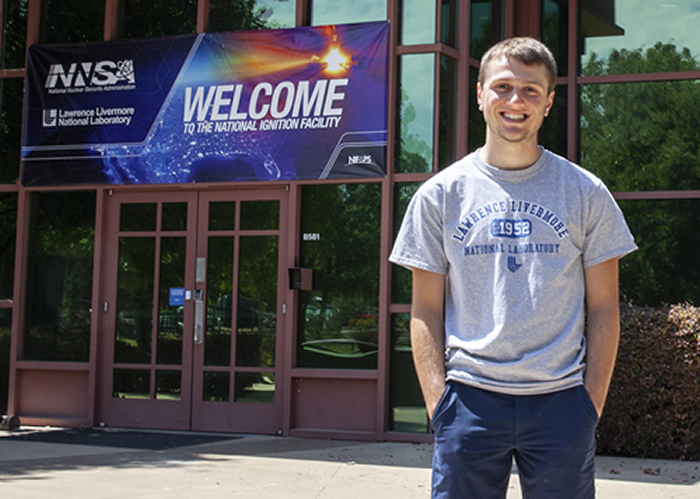 Zach DiPasquale is relishing his summer at NIF. Credit: Mark Meamber
Zach DiPasquale is relishing his summer at NIF. Credit: Mark Meamber Even in just a few weeks, the work of the fourth-year software engineering major from Rochester Institute of Technology in Rochester, New York, should pay dividends at NIF for years to come, said Mike Flegel, integration manager for the NIF control systems.
“Any time we can automate a process and take the human out of the loop, it’s always a benefit,” Flegel said.
Flegel described ICCS as a “monstrous system” with 2.5 million lines of code that manages more than 60,000 control points “to make sure NIF fires on track, on target, with the right amount of energy so the experimentalists can get the data they’re looking for with regards to basic science, material science, fusion, and weapons research.”
Software revisions go on constantly and the system is completely rebuilt nightly, Flegel said. More than 12,000 tests can be performed with automated tools, but more comprehensive, human-run tests can take hours or even days. Part of the testing environment involves hundreds of computers, Flegel said.
DiPasquale’s project is to introduce continuous integration, a process that lets developers frequently integrate new software into a shared test system that automatically verifies that each build functions properly before integrating it into the main system.
“You build, you test, you integrate and provide feedback to the developers, so they know when they put something into the system, all the builds and the tests that are run tell them whether or not their code was successful,” Flegel said.
So DiPasquale’s task was “to build us a system that will allow that to happen,” Flegel said. “This is an opportunity to automate my job so that I can move on to other projects. In software, that’s the goal.”
It was a formidable undertaking for a student who didn’t know the Lab existed before he learned of the internship opportunity through the Rochester Institute of Technology.
“I didn’t know much about what they did, but did research about the Lab, found it pretty interesting, with a lot of interesting stuff going on,” DiPasquale said. “I thought NIF was actually a really cool piece of technology.”
The NIF summer project also fit his passion for designing software applications, which he said he enjoyed more than “just sitting down and programming.”
He also had some experience with continuous integration at a previous job and through school, although this was the first time he’s developed a pipeline for the continuous integration process to feed software builds into the system, he said.
And NIF is one of the few places in the world where he could tackle a project involving more than 2.5 million lines of Java and Ada computer language programming.
“But I knew the principles and what was needed to be done in order to do the job, so I was prepared to come into it,” he said.
Some Tough Questions
DiPasquale also had to present his work to a group of NIF’s top leaders and answer some tough questions.
The changes could have a big impact on the way NIF developers work, “so getting them to understand these changes and how it’s going to improve their workflows is an important part,” he said. “I just kind of went with the flow and tried to do what I needed to do to get my ideas across. You have to be honest and say why you chose that idea and how it’s going to benefit in the long run.”
The nature of software engineering prepared him to handle such challenges, he said.
“It’s part of software engineering,” said DiPasquale, who began creating websites when he was in middle school. “You prepare for those challenges from the beginning. When they pop up, you have to absorb it, fix up your design, and continue forward.”
Flegel said the project still needs fine tuning and other features need to be incorporated before there can be a technology handoff to integrate the system into daily operations, but he praised DiPasquale’s work.
“Personally, it’s helped me to work with Zach and understand our process better,” Flegel said. And, he added, “We need this capability moving forward.”
New Fiber Optics Design Measures NIF Beamline Performance
Dylan Beckman’s route to NIF began when he first toured the University of Rochester’s optical engineering building and knew he wanted to work with lasers.
“I’d never seen anything as cool as an optical lab table,” he said. “It just looked like something so futuristic and science fiction-like to me. I came in thinking I was going to do chemical engineering. That went straight out the window as soon as I saw the optics lab.”
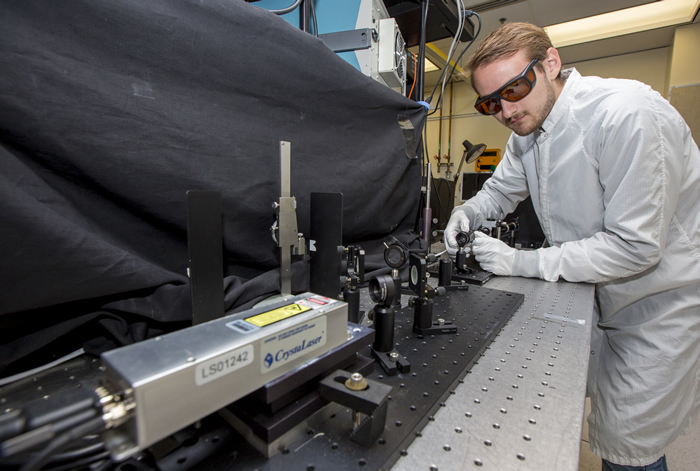 NIF summer scholar Dylan Beckman works on a prototype optical system. Credit: Jason Laurea
NIF summer scholar Dylan Beckman works on a prototype optical system. Credit: Jason Laurea Beckman, 20, is one of this year’s NIF & Photon Science summer scholars, helping to design from scratch new ways for optical fiber cables to transport ultraviolet light from inside the Target Chamber to external diagnostic instruments. His designs may eventually be used for all 192 NIF beams.
His work has impressed his mentors, Abe Handler and Leyden Chang of the NIF Laser Diagnostics Group, and Mike Messerly, Fiber Laser Group leader.
Beckman’s designs for a more complex optical lens system that takes load off the fiber “has been a big help to us,” Messerly said. “We think going forward, his designs are going to make our lives easier and everybody happier.”
Beckman will soon start his senior year as an optical engineering major. At NIF, Handler said he challenged the intern with “developing and designing this optical system, which simplifies, reduces costs, and gives new capabilities to NIF.”
Using the FRED optical engineering software platform, Beckman looked at ways to pick off portions of light from beams to perform measurements. Only a fraction of the facility’s beams has such measurement devices, Handler said.
Beckman was tasked with taking a system originally designed in the 1990s, “wiping that clean and starting with a fresh, empty box,” Handler said.
At present, power is measured only in a quarter of NIF’s beamlines, with computer modeling filling in the rest of the information. Beckman is developing a system that could be built for all 192 beamlines, which would reduce the uncertainty in the measurements and to give scientists, engineers and other users greater confidence in laser performance.
This would be an upgrade that NIF needs for the future. “The more information you know about each beamline, the more you can characterize your system,” Handler said. “The better you understand it, the more energetic you can go with it.”
Beckman is working on physical prototypes, which he hopes to finish before returning to school.
“We’re looking at doing this as cheaply as possible, so that’s very challenging,” Handler said. “The bigger picture is that this helps everybody who runs the facility and uses NIF.”
The private telecommunications industry widely uses fiber optic cables to transmit voice and data over long distance. But NIF requires custom fiber optics to transmit the ultraviolet (UV) light produced when its laser beams approach the Target Chamber, Messerly said.
“It’s not an off-the-shelf thing,” he said. “Carrying the UV light is difficult. And having the fiber that can tolerate a high-radiation environment is tough, too.
We’ve come up with designs that greatly simplify what this fiber is going to need to do,” Messerly said. “And if we’re going to put fiber on every one of these beamlines, we can make enough to populate those beamlines in a reasonable amount of time.”
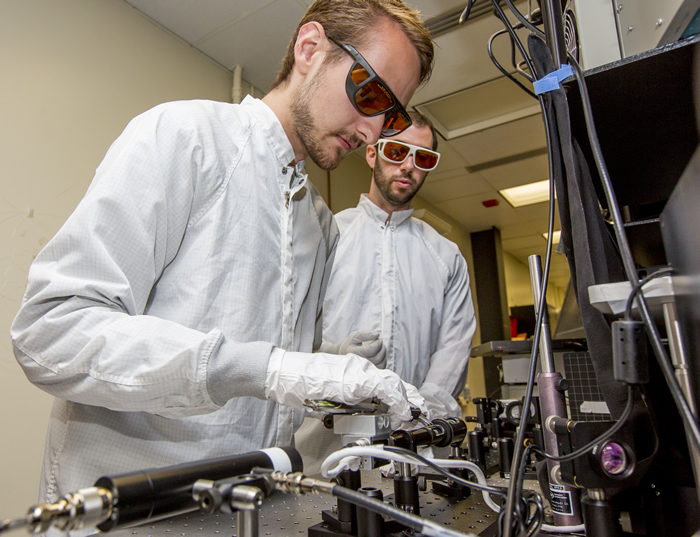 Beckman (left) and mentor Abe Handler tweak the optical system prototype. Credit: Jason Laurea
Beckman (left) and mentor Abe Handler tweak the optical system prototype. Credit: Jason Laurea Admittedly, NIF “can be daunting to people that work here, let alone someone who’s coming here as an intern,” Handler said. “It’s a huge undertaking, it’s a huge task. It has to work in lots of different scenarios. So, we gave him a set of requirements, gave him a blank slate and we just left it up to him.”
Beckman jumped in with both feet and “showed a high degree of skill right away,” Handler said.
To be sure, Beckman was properly in awe of NIF.
“The scale of NIF never ceases to amaze me,” Beckman said. “Every time I get a tour, go into the Target Bay room and you see that giant Death Star-looking thing, it’s crazy, it looks really awesome. It’s so impressive to me that there’s so much working together in one giant well-oiled machine.”
Was he excited or scared?
“A bit of both,” he acknowledged. “I thought it was really cool that as an intern, I got a project of this scope. I’ve heard stories about other interns at other places just doing busy work. But to get thrust right into a role where I’m actually doing optical design, and I’m doing it on such a big scale on the world’s largest laser, I was mostly in awe at first.”
But once he immersed himself in the project and talked to his mentors, “it definitely didn’t seem so daunting,” he said. “It’s nice to have really smart people to work with to help me through it.
“I’m hoping it’s something that can actually be integrated into NIF,” Beckman said. “That’d be really awesome, to have my name on something that was put into the world’s largest laser. ”




